Fruit-surface flavonoid accumulation in tomato is controlled by a SlMYB12-regulated transcriptional network
- PMID: 20019811
- PMCID: PMC2788616
- DOI: 10.1371/journal.pgen.1000777
Fruit-surface flavonoid accumulation in tomato is controlled by a SlMYB12-regulated transcriptional network
Abstract
The cuticle covering plants' aerial surfaces is a unique structure that plays a key role in organ development and protection against diverse stress conditions. A detailed analysis of the tomato colorless-peel y mutant was carried out in the framework of studying the outer surface of reproductive organs. The y mutant peel lacks the yellow flavonoid pigment naringenin chalcone, which has been suggested to influence the characteristics and function of the cuticular layer. Large-scale metabolic and transcript profiling revealed broad effects on both primary and secondary metabolism, related mostly to the biosynthesis of phenylpropanoids, particularly flavonoids. These were not restricted to the fruit or to a specific stage of its development and indicated that the y mutant phenotype is due to a mutation in a regulatory gene. Indeed, expression analyses specified three R2R3-MYB-type transcription factors that were significantly down-regulated in the y mutant fruit peel. One of these, SlMYB12, was mapped to the genomic region on tomato chromosome 1 previously shown to harbor the y mutation. Identification of an additional mutant allele that co-segregates with the colorless-peel trait, specific down-regulation of SlMYB12 and rescue of the y phenotype by overexpression of SlMYB12 on the mutant background, confirmed that a lesion in this regulator underlies the y phenotype. Hence, this work provides novel insight to the study of fleshy fruit cuticular structure and paves the way for the elucidation of the regulatory network that controls flavonoid accumulation in tomato fruit cuticle.
Conflict of interest statement
The authors have declared that no competing interests exist.
Figures

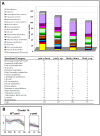

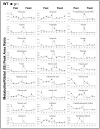
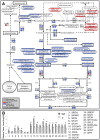



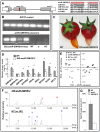
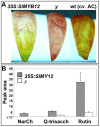
References
-
- Samuels L, Jetter R, Kunst L. First steps in understanding the export of lipids to the plant cuticle. Plant Biosystems. 2005;139:65–68.
-
- Muir SR, Collins GJ, Robinson S, Hughes S, Bovy A, et al. Overexpression of petunia chalcone isomerase in tomato results in fruit containing increased levels of flavonols. Nature Biotechnology. 2001;19:470–474. - PubMed
-
- Luque P, Bruque S, Heredia A. Water permeability of isolated cuticular membranes: a structural analysis. Arch Biochem Biophys. 1995;317:417–422. - PubMed
-
- Willits MG, Kramer CM, Prata RT, De Luca V, Potter BG, et al. Utilization of the genetic resources of wild species to create a nontransgenic high flavonoid tomato. J Agric Food Chem. 2005;53:1231–1236. - PubMed
Publication types
MeSH terms
Substances
LinkOut - more resources
Full Text Sources
Other Literature Sources
Molecular Biology Databases

